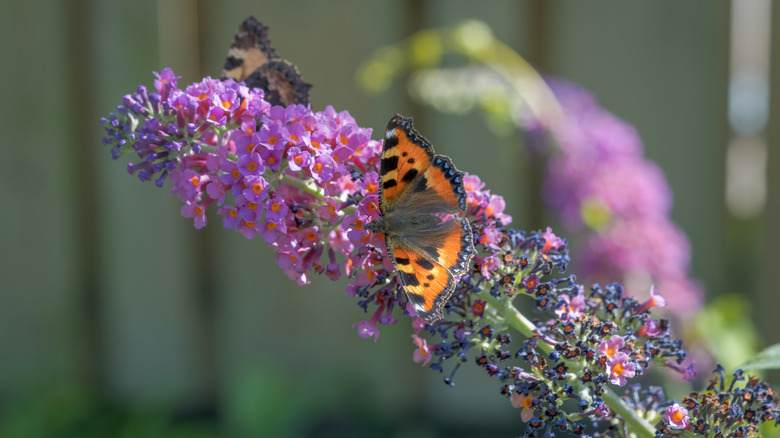The Iconic Companion Plant That Works Beautifully Alongside Passionflowers
Passionflowers are absolute showstoppers with their weird and intricate blooms that can add drama to any flower garden. But these stunning climbing vines and their gorgeous flowers are more than just pretty on the eye; they're also a wonderful way to fill your garden with a variety of butterflies. The butterfly bush (Buddleja davidii) makes a wonderful companion plant for passionflowers because it helps foster a buzzing ecosystem of pollinators and sustains the full life cycle of butterflies in your garden.
As the name implies, butterfly bush is a bush that butterflies absolutely love. These stunning flowering shrubs can grow quite large, up to 10 feet tall and wide. They grow quickly and are semi-evergreen, which means they will lose their leaves in winter and sometimes die back, but their roots can survive and bring you a brand new bush the following season. They grow cone-shaped clusters of small flowers that come in a variety of pink and purple hues.
Companion planting benefits your garden in many ways, such as improving soil quality, deterring pests, or attracting pollinators and other beneficial insects. But good companion planting is also about finding species that thrive in similar environments. For the passionflower, that means looking for plants that enjoy similar well-draining soil and full-sun conditions. In addition, both plants need to grow in the same regions of the United States, and at similar periods. Luckily, butterfly bush thrives in USDA Hardiness zones 5 to 9, which overlaps closely with passionflowers' zones 6 to 10, and both will bloom in summer. With these things in mind, you can successfully grow and care for passionflowers and their beloved companion, butterfly bushes.
How to grow butterfly bush and passionflowers as companion plants
Both passionflowers and butterfly bushes help sustain a healthy butterfly population in your yard in completely different ways, making them amazing neighbors and collaborators. Passionflowers are host plants for several butterfly species that like to lay their eggs on the plant. Although the passionflower plant tries to fight this off by creating faux eggs to deter butterflies, they're still a crowd favorite for baby hatching. Parent butterflies will appreciate having butterfly bush nearby, and once hatched, caterpillars will munch on the passionflower leaves and eventually form a chrysalis. After emerging as butterflies, they'll make their way to the butterfly bush and its nectar-filled flowers to snack. When it's time to hatch their own eggs, they can return to the passionflower plant. Voila, you've helped a whole family of butterflies through generations thanks to companion planting!
When planting these two companion plants together, keep in mind their scale and needs. As mentioned, butterfly bushes can grow quite large, so you'll want to place them 10 feet away from other plants or walls, so that they can spread without swallowing their neighbors. Passionflower plants are climbing vines, so you'll want to set them up on a trellis or fence where they can spread out. The good news is that butterflies have wings, so they'll easily find their way from one plant to the other.

